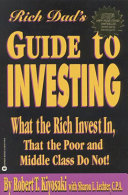

In 'Rich Dad's Guide to Investing', Robert Kiyosaki emphasizes the necessity of financial education as a cornerstone for successful investing. He argues that traditional education systems often neglect to teach students about money management, investing, and wealth-building strategies. Kiyosaki believes that to become a successful investor, one must understand the fundamental principles of finance, including cash flow, assets, liabilities, and the various investment vehicles available. This knowledge empowers individuals to make informed decisions, recognize opportunities, and avoid common pitfalls. Kiyosaki also stresses the importance of continuous learning, suggesting that investors should stay updated on market trends, economic conditions, and new investment strategies. By prioritizing financial education, individuals can develop the confidence and skills necessary to navigate the complexities of investing and ultimately achieve financial independence.
Continue readingA key concept in Kiyosaki's philosophy is the distinction between assets and liabilities. He defines assets as anything that puts money in your pocket, such as investments, real estate, and businesses. Conversely, liabilities are expenses that take money out of your pocket, such as mortgages, car loans, and credit card debt. Kiyosaki argues that to build wealth, individuals should focus on acquiring assets while minimizing liabilities. This principle encourages readers to think critically about their financial decisions and to prioritize investments that generate passive income. By understanding the difference between assets and liabilities, individuals can create a solid financial foundation and work towards achieving financial freedom. Kiyosaki also highlights the importance of cash flow management, as positive cash flow from assets can provide the resources needed to acquire more investments.
Continue readingKiyosaki emphasizes that a successful investor must cultivate a mindset geared towards growth and opportunity. This involves adopting a proactive approach to financial challenges and viewing setbacks as learning experiences. He contrasts the mindset of the 'Rich Dad' with that of the 'Poor Dad,' illustrating how attitudes towards money and investing can significantly impact one's financial success. The 'Rich Dad' embraces risk and is willing to take calculated chances, while the 'Poor Dad' tends to play it safe, often missing out on potential opportunities. Kiyosaki encourages readers to develop resilience, creativity, and a willingness to learn from mistakes. By fostering a growth mindset, individuals can become more adaptable in the face of changing market conditions and better positioned to seize opportunities as they arise.
Continue readingKiyosaki argues that one of the best investments an individual can make is in themselves. This includes acquiring new skills, enhancing knowledge, and developing personal attributes that contribute to success in investing and life. He advocates for continuous self-improvement through education, networking, and mentorship. By investing in oneself, individuals can increase their marketability, expand their professional networks, and gain insights that can inform their investment strategies. Kiyosaki also emphasizes the importance of emotional intelligence and interpersonal skills, which can enhance one's ability to negotiate deals and build relationships in the business world. Ultimately, investing in oneself lays the groundwork for long-term success and empowers individuals to take charge of their financial futures.
Continue readingKiyosaki stresses the importance of understanding market cycles and economic trends in the context of investing. He explains that markets go through phases of expansion and contraction, and astute investors must learn to recognize these cycles to make informed decisions. By understanding when to buy and sell assets, investors can maximize their returns and minimize losses. Kiyosaki also discusses the impact of external factors, such as government policies, interest rates, and global events, on market behavior. He encourages readers to stay informed about economic indicators and to develop a keen awareness of market dynamics. By mastering the art of timing in investing, individuals can position themselves to take advantage of opportunities and navigate downturns more effectively.
Continue readingKiyosaki believes that entrepreneurship plays a vital role in successful investing. He argues that building a business can create substantial wealth and provide valuable experience in managing finances, understanding markets, and developing innovative solutions. Kiyosaki encourages readers to think like entrepreneurs, identifying gaps in the market and creating value through their investments. By adopting an entrepreneurial mindset, individuals can approach investing with creativity and a willingness to take calculated risks. Kiyosaki also highlights the importance of networking and collaboration, as entrepreneurs often rely on partnerships and relationships to grow their ventures. Ultimately, embracing entrepreneurship can enhance one's investment portfolio and lead to greater financial success.
Continue readingKiyosaki emphasizes the necessity of taking action in the world of investing. He acknowledges that fear and uncertainty can paralyze potential investors, preventing them from making decisions and seizing opportunities. Kiyosaki encourages readers to confront their fears and take calculated risks in pursuit of their financial goals. He believes that inaction often leads to missed opportunities and stagnation. By taking small, manageable steps towards investing, individuals can build confidence and gradually expand their investment portfolios. Kiyosaki also stresses the importance of learning from experience—both successes and failures—as a means of growth. By overcoming fear and taking action, individuals can move closer to achieving financial independence and building wealth.
Continue reading